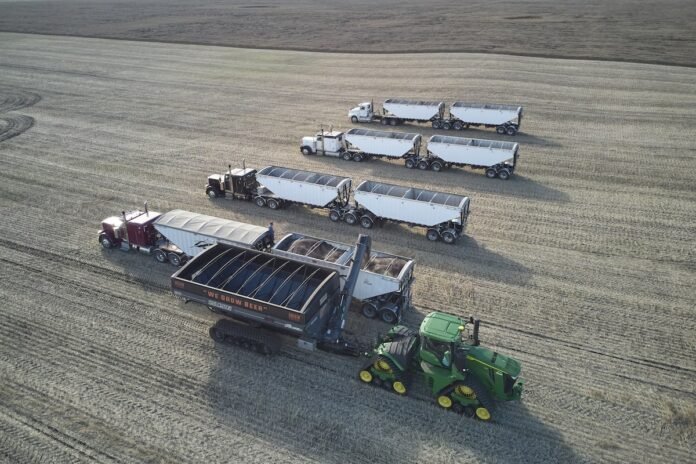Hilton Ventures farms harvest canola on September 25 at their farm near Strathmore, Alta. Agriculture is just one example where broadband is making a material difference in rural communities.Todd Korol/The Globe and Mail
Gregory Taylor, associate professor in the department of communications at the University of Calgary, and Michael B. McNally, associate professor in the faculty of education at the University of Alberta, are co-chairs of the Alberta Rural Connectivity Coalition’s policy committee.
From broken water pipes to public transportation issues, infrastructure has been a top priority for many Albertans in recent months. But there is another fundamental challenge at play in rural areas, where demand for digital connectivity remains a persistent problem that has proven resistant to traditional market-driven initiatives. In rural Alberta, the lack of high-speed internet access limits the growth potential and economic prospects for small towns and farms. Recent CRTC data underlines the situation, showing that Alberta now ranks last among Canadian provinces in rural connectivity.
This has not always been the case. In 2001, the province led the way in rural connectivity when it announced the construction of the publicly funded Alberta SuperNet broadband network. The Progressive Conservative government trumpeted at the time that “Alberta has established itself as a world leader in the new global economy.” In twenty years, the province has gone from leader to laggard in this important area. The debates over productivity and technology are not limited to the cities and oil fields of Alberta, they are also taking place in small towns and in the cabs of tractors and combine harvesters.
Although often far removed from urban digital hubs, Canadian farmers are not Luddites; Modern agricultural machinery includes a strong component of digital technology and connectivity, using a steady stream of data to maximize crop yields. There are as many as 125 software-connected sensors in a modern John Deere combine, and multiple on-board computer screens are commonplace. In 2024, John Deere announced a deal with SpaceX to connect tractors to satellite internet.
Agriculture is just one example where broadband is making a material difference in rural communities. Any productivity problem stems not from the farming community, which has traditionally been an early adopter of new technologies, but from the ability of these areas to stay connected and share and use the data that is an essential part of modern agriculture.
According to the most recent CRTC statistics (2022), just over 40 per cent of households in rural Alberta have access to what the commission considers the Canadian definition of high-speed broadband. In British Columbia, which has a much more challenging topography for broadband rollout, 66 percent of rural households are covered. In Quebec, the largest province, 85 percent of rural homes have coverage. Alberta has lost the advantage it once had in rural connectivity.
SuperNet, which connects 429 communities across the province, has clearly failed to deliver on its earlier promise. High connection costs have prevented many small, local Internet providers from using SuperNet as originally envisioned, to provide the accessible fiber backbone for last-mile connections.
Alberta’s connectivity issues have been a growing problem for some time. In the 2021 federal election, rural broadband access was the top priority for Alberta’s rural municipalities. A year later, the province introduced a strategy with the aim of having high-speed broadband available in every household in the province by April 2027. The ambitious plan includes $780 million in combined federal and provincial spending to close the gaps.
But the admirable goal of 100 percent coverage is somewhat misleading, as the plan includes low-Earth orbit satellites when calculating connectivity. This important detail essentially ensures that the goal of 100 percent connectivity is achieved via Starlink satellite internet. Unsurprisingly, the plan’s rollout has been slow, with only a quarter of the funding allocated in the past two years. Clearly, the Alberta government is hoping Elon Musk will do the rest. While Starlink is promising, it is not a reliable replacement for internet connected to a nearby fiber optic line.
Not trading is not without costs. Without rural connectivity, there will be even greater migration to the cities, putting further pressure on urban infrastructure and weakening productivity in rural areas. High-speed broadband is no guarantee of success, but poor connectivity is creating a disconnect from the wider modern economy.





